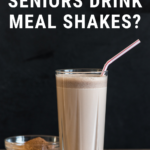
Caregiving can involve many different food-related challenges, including seniors being reluctant to eat and needing soft food. Nutritional shakes for seniors are often viewed as a solution. You might even see them promoted in doctor’s offices.
But, are they as good as they seem?
The Advantages
- Nutritional shakes are easy. Many products (like Boost and Ensure) come prepackaged. They simply need to be opened and consumed. This may be particularly relevant for seniors who cannot safely cook.
- They save time. Cooking food is always ideal, but it isn’t always realistic. It’s nice to have a backup option for when you’re short on time or when the day just isn’t going to plan.
- They taste good. This is product-specific, but many protein shakes do taste really good. That’s particularly true for many Boost and Ensure products (mostly because they’re high in sugar). Seniors often feel like they’re drinking a chocolate milkshake. This can dramatically reduce resistance to eating.
- They can get around some eating challenges. Seniors often experience decreased taste and appetite. Eating can get more difficult too. Shakes help to get around this, as they’re easy to drink and taste good.
- You can find coupons and discounts. There are often coupons for shakes, like at the doctor’s office or in newspapers. Some brands can also be purchased in bulk from places like Costco, which decreases the price per shake.
The Disadvantages
- The shakes are often high in sugar. For example, Ensure Original has 220 calories per serving, 9 grams of protein and 15 grams of sugar.
- They’re typically processed. Ready-to-drink shakes need to be shelf-stable and not too expensive to make. As a result, they are processed. They also include various additives and artificial flavorings.
- They’re not as filling as a real meal. While shakes have some advantages, they’re never going to completely replace food. People often get hungry soon after.
- Over-consumption is easy. The shakes are often small and high in calories. This makes it easy for people to consume too many. This is particularly significant for seniors with memory challenges, as they may not remember that they’ve already had one shake.
Should You Use Nutritional Shakes for Seniors?

Nutritional shakes for seniors can be powerful in some situations. They provide the nutrients that seniors need in a form that is easy to consume. Many seniors will even enjoy the shakes, despite turning down many other meals.
Yet, the products are also highly processed and are often laden with sugar. They could even promote obesity in sedentary seniors that are consuming too many calories.
Whether shakes are a good idea or not will depend on your situation. But, here are a few key areas to look at.
1. Choose Shakes Based on Need
Some shakes are healthier than others. For example, many of the Ensure and Boost shakes are high in sugar and aren’t that impressive for nutrients. Brands that aren’t targeted at seniors often have more protein and/or nutrients, along with less sugar.
Unless a high sugar product is important, try to choose something healthier.
2. Use Protein Powder, Fruit and Veggies
If you have the time and resources, it’s much healthier to make your own shakes. You can rely on protein powders as a base, then add in healthy ingredients like nuts, chia seeds, fruit,
Just make sure that the protein powder isn’t high in sugar.
When you make healthy decisions about ingredients, you can end up with a much better shake. You also have full control over the flavor.
You can often make a shake that tastes much better than the purchased ones, while also containing more protein and less sugar.
3. Check with their Doctor
Regardless of whether the doctor is likely to approve or not, you do need to know whether there are any health risks when giving seniors a nutritional shake.
There is a chance that the shake will cause issues, simply because it contains many different nutrients.
For example, some seniors need to closely monitor vitamin K intake, while others need to limit sugar. Either pattern could make some shakes a bad idea.
4. Don’t Use Them Every Time
Nutritional shakes are often used to replace one meal a day, or less regularly than that. In most situations, the senior should still be having some of their food as a meal.
The shakes simply don’t provide everything that a person needs in the long-term and they don’t normally keep people full for as long as a meal.
5. Use Your Instincts
Finally, go with what works for your situation.
Prepackaged shakes aren’t the healthiest products in the world – but that doesn’t always matter. Some days it’s more important to make sure your family member eats, rather than stressing about the best possible food.
You might also find that you simply need the extra time that a prepackaged shake gives you.


Leave a Reply